Physical Address
304 North Cardinal St.
Dorchester Center, MA 02124
Congenital abnormalities of the upper extremities are those that occur during the embryonic period. Developmental deformities are those that occur primarily in the fetal or neonatal period. Because a developmental deformity may have a prenatal association, such as in utero positioning, it could be misinterpreted as a congenital abnormality. Congenital and developmental disorders of the upper extremities are less common than those affecting the lower extremities.
The failure of the scapula and the upper extremities to descend to their normal locations is called Sprengel deformity, which can vary from mild to severe. In this condition, the scapula is typically located abnormally elevated with respect to the child's neck and thorax, producing webbing of the skin at the base of the neck and a low posterior hairline. In the severe form, an accessory bone (the omovertebral bone) may connect the scapula to the spinous processes of the cervical spine and allow virtually no scapulothoracic motion. The severe forms are more likely than the mild forms to be diagnosed in the neonate. Associated muscle contractures that further limit the strength and stability of the shoulder girdle may also be present. In the mild form, the scapula is slightly elevated, with less than normal motion. There may be an association with congenital cervicovertebral abnormalities, particularly Klippel-Feil syndrome, and this association suggests the possibility of other congenital abnormalities, such as those in the cardiovascular and genitourinary systems. When Sprengel deformity is diagnosed, abnormalities in these other systems must be assessed.
Treatment is usually delayed until middle childhood and depends on the function of the child's shoulder and extremity. In severe forms, surgical repositioning and occasionally partial resection of the scapula may be necessary.
Congenital radioulnar synostosis is an uncommon disorder that represents a failure of separation, or congenital fusion, between the proximal radius and ulna. It occurs from the 5th to the 8th week of gestation, when there is separation of the humerus, radius, and ulna from a common block of cartilage in the limb bud. This disorder is bilateral in approximately 50% of all patients and limits forearm pronation and supination. It is rarely recognized during the neonatal period, because there is no obvious deformity, only a loss of forearm rotation. In most cases, the forearm is in a physiologic position of 45-60 degrees of pronation. Only if there is extreme supination may the disorder be recognized in the neonatal period. The diagnosis of this disorder, which is confirmed radiographically, should be suspected in any neonate with restricted forearm pronation or supination.
Treatment is rarely indicated unless there is an abnormal position of the forearm that interferes with the function of the hand. The method of treatment, a rotational osteotomy through the synostosis, is usually delayed until middle childhood so that an adequate assessment of function can be determined. Attempts at restoring forearm pronation and supination by excising the synostosis have been unsuccessful.
Hypoplasia of the radius is a commonly discussed and infrequently encountered entity, occurring in 1 in 100,000 live births. It is bilateral in 50% of cases. The deformity can vary from mild shortening of the radius to its complete absence (e.g., radial clubhand). As the radius shortens, the deformity becomes more apparent. In complete absence of the radius, the hand is radially angulated 90 degrees to the long axis of the forearm, the ulna is markedly bowed, and the ulna and humerus can be one-half the length of the opposite normal side by maturity. As the deformity becomes profound, so does thumb involvement (e.g., an absent first ray, thumb hypoplasia) ( Fig. 99.1 ).
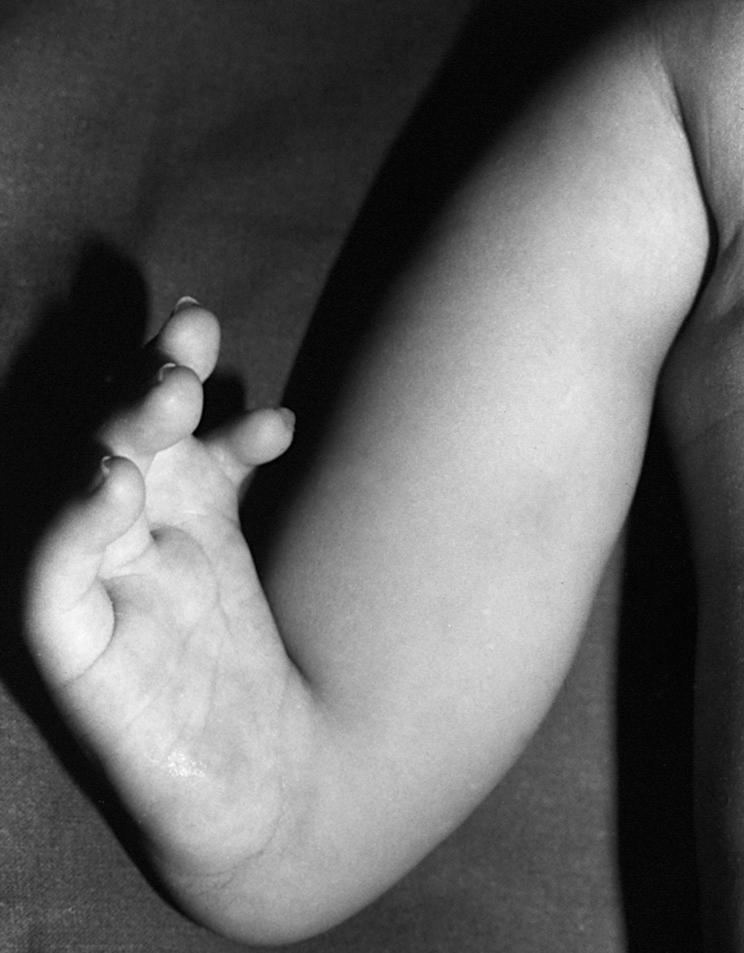
The entire extremity may be involved, including the scapula and clavicle. The radially based muscles of the forearm are also hypoplastic or absent. There is hypoplasia or absence of the radial artery, leaving the ulnar artery as the main blood supply to the hand. There is no radial nerve innervation to the skin distal to the elbow, leaving the median and ulnar nerve to anastomose to provide dorsal sensation. Radial clubhand is not simply a bony defect.
The most frequently associated abnormalities are blood dyscrasias and heart defects. Fanconi syndrome is a pancytopenia seen in some children with radial clubhand (see Chapter 79 ). Thrombocytopenia with an absent radius (TAR) syndrome is also seen. Holt-Oram syndrome, in which the primary manifestation is an absent thumb with atrioseptal defects, has a well-recognized association with radial clubhand.
Radial hypoplasia alone is inherited sporadically. There is no definitively identifiable inheritance pattern; the careful scrutiny of relatives seldom yields another affected individual. However, radial hypoplasia as part of a syndrome frequently has a defined inheritance pattern. Holt-Oram syndrome is inherited in a dominant pattern and Fanconi syndrome is inherited in a recessive pattern.
Treatment comprises both operative and nonoperative options and is recommended for cosmetic and functional reasons. The treatment begins with stretching. During the first 6 months of life, casts and splints are used to stretch the radially deviated hand to conform to a more neutral alignment. If the deformity is corrected, the patient wears a splint full-time for the first 6 years of life and then only at night after that. If the deformity is not corrected, the hand is centralized onto the ulna. At surgery, the carpus is fused to the ulna after an osteotomy to straighten the ulna. If the patient has a nonfunctional thumb, the index finger occasionally undergoes pollicization—in essence, it is turned into a thumb. The surgery is frequently performed when the patient is between 6 months and 1 year of age. After surgery, bracing is maintained full-time for the first 6 years of life. In bilateral cases, the surgery is staged, with one hand operated on at 6 months and the other hand at about 3 years of age.
The contraindications to surgery are a serious blood dyscrasia, heart problems, and profound muscle imbalance. If the elbow flexors are overpowered by the elbow extensors such that a child cannot touch the hand to the face even after physical therapy, surgery is not likely to provide a functionally useful hand.
Congenital constriction bands or amniotic band syndrome, also known as Streeter dysplasia or annular bands, features defects of the skin that result in ringlike strictures about the limbs and occasionally the trunk ( Fig. 99.2 ). It is seen in 1 in 15,000 live births, and multiple extremities are usually involved. The upper extremities, especially the hands, are involved more frequently than the lower extremities. The cause appears to be early amniotic rupture followed by temporary oligohydramnios; this may result in intrauterine compression and the subsequent constriction of fetal appendages by cords or bands of torn amnion (see Chapter 24 ).
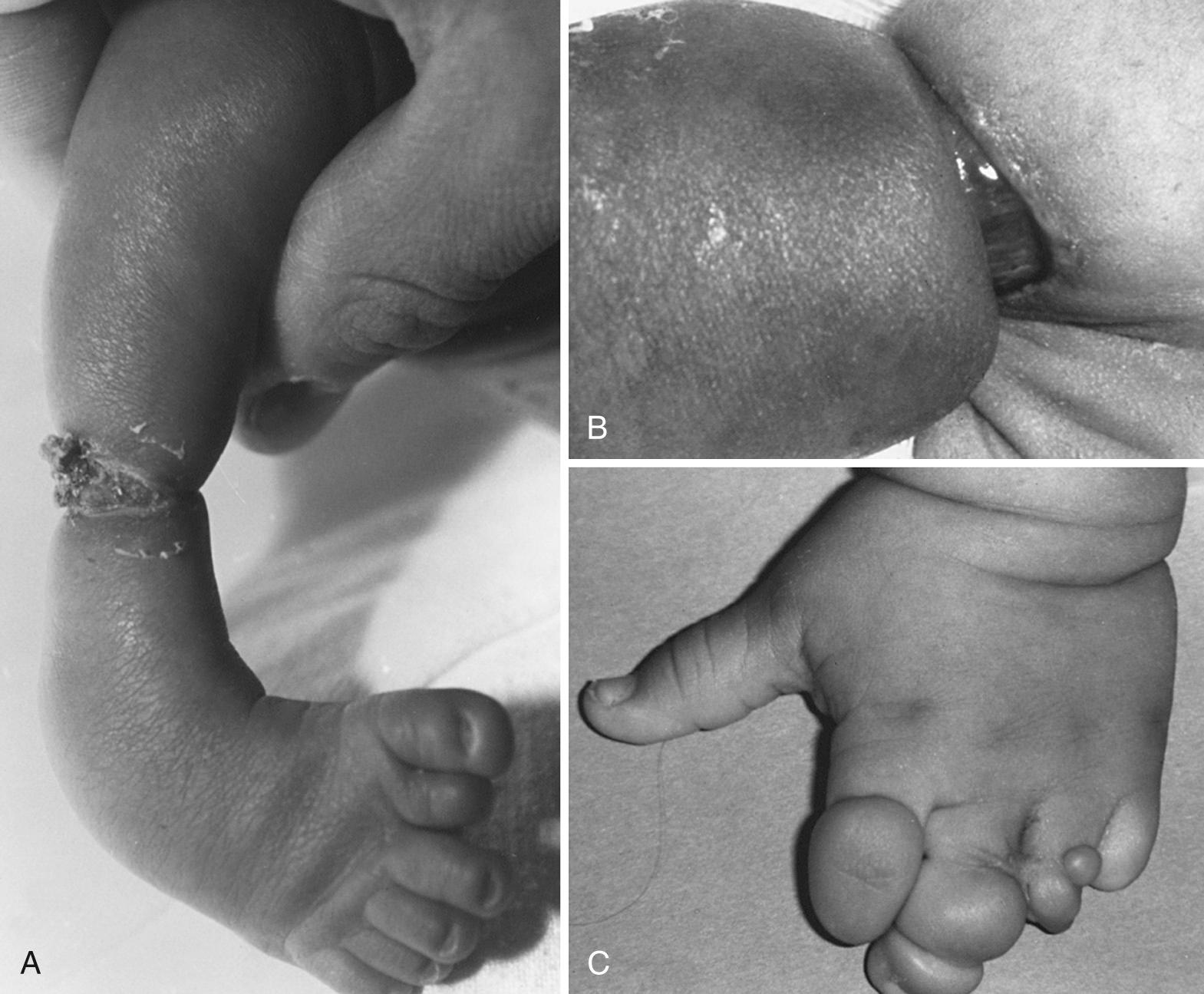
Patterson developed diagnostic criteria for congenital constriction band syndrome. These criteria include simple band constrictions; band constrictions accompanied by deformity of the distal part with or without lymphedema; band constrictions accompanied by fusions of distal parts ranging from fenestrated or terminal syndactyly (e.g., acrosyndactyly) to exogenous syndactyly; and intrauterine amputations. Other congenital abnormalities frequently occur, such as clubfoot (30%), pseudarthrosis, peripheral hand palsy, and lower extremity length discrepancies.
Rigid clubfoot distal to deep constriction bands may be difficult to correct. Treatment involves the surgical release of the bands if the distal aspect is swollen and has lymphedema. The surgery is usually performed in two stages, although Greene has demonstrated that a complete one-stage release can be performed safely.
Congenital amputation is the best example of a failure of formation. In general, the greater the loss of length, the rarer is the lesion. For instance, a child with congenital amputation at the forearm level is encountered in 1 in 20,000 live births, and one with a missing arm is encountered in 1 in 270,000 live births.
When treating patients with congenital amputations of the upper extremities, it is necessary to define a goal for the patient. The arm serves as a positioning device for the hand. Consequently, treatment revolves around providing the patient with some sort of terminal device at the end of the usable arm. In the earlier stages, as the child achieves sitting balance, a soft terminal device is fitted. This device allows “two-handed” activities and is used to help pin objects against the normal hand. As the child reaches 2-3 years of age, prehension by means of a terminal device becomes possible. Early training allows children to become quite comfortable with these devices.
Syndactyly is the most common form of congenital abnormality in the upper extremities and represents a failure of separation of two fingers ( Fig. 99.3 ). This failure of separation occurs sometime between 5 and 8 weeks of gestational life and is seen in 1 in 2250 live births. The abnormality appears to be sporadic in 80% of cases; the other 20% are the result of genetic transmission. Because all forms of genetic transmission have been linked to syndactyly, genetic counseling is quite difficult. The classification of syndactyly is defined by the degree of interconnection between the fingers. In complete syndactyly, the webbing extends to the tips of the fingers; in incomplete syndactyly, it does not. Simple syndactyly involves only the skin, whereas complex syndactyly involves bony fusion. Abnormalities of the blood vessels, nerves, and tendons are also seen.
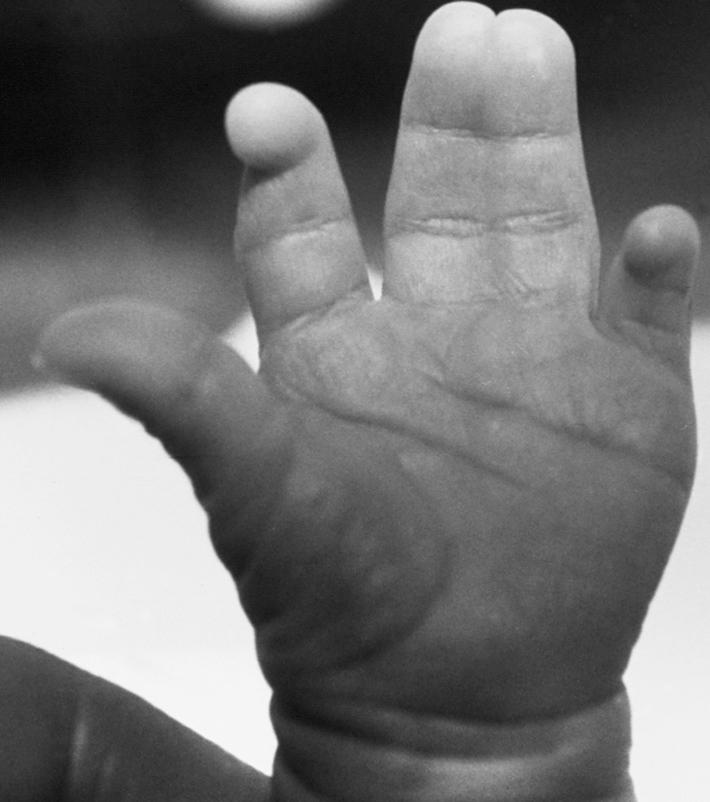
Treatment is aimed at separating the digits to improve function. The affected digits are usually separated early, particularly when they are of unequal length. If the thumb and index finger are syndactylized, the longer digit becomes tethered and deformed by the shorter digit. Surgery within the first year of life is suggested. When the digits are of nearly equal length, such as the long finger and the index finger, the surgery can wait until 2 or 3 years of age without difficulty.
See Chapter 30 . Polydactyly is a common duplication abnormality of the hand ( Fig. 99.4 ). It is seen in 1 in 300 African-American and 1 in 3000 Caucasian live births in the United States. The incidence of thumb polydactyly is identical in African Americans and Caucasians (0.8 in 1000 live births). Little-finger polydactyly is common in African Americans, with 1 in 300 affected, and is usually seen without associated abnormalities. In Caucasian infants, little-finger polydactyly is infrequent and often associated with other skeletal abnormalities, including syndactyly, coalescence of carpal bones, radioulnar synostosis, hypoplasia and aplasia of the tibia and fibula, hemivertebrae, and dwarfism. Other disorders also seen are hydrocephalus, cleft lip, hypogonadism, kidney abnormalities, and imperforate anus.
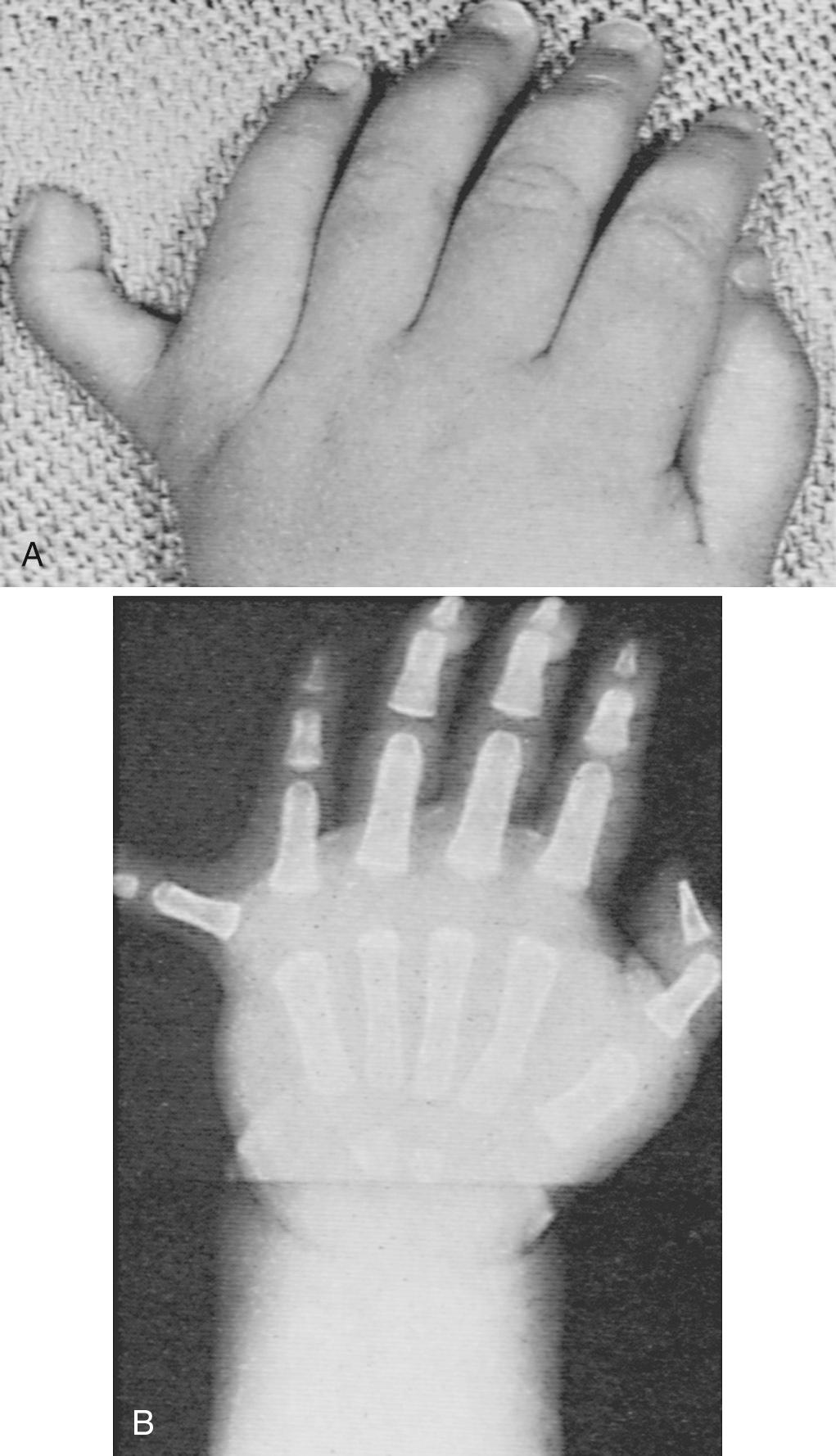
The surgical approach to polydactyly is based on the vascular and bony anatomy of the digits, and it is individualized. The surgery is usually performed sometime after 6 months but before 18 months of age to minimize the anesthetic consequences.
Macrodactyly of the hand, also known as idiopathic local gigantism, may involve one or more fingers and is bilateral in 5% of cases. All structures in the affected finger are enlarged, including the bone, blood vessels, nerves, and other soft tissues. True macrodactyly must be differentiated from other processes that create gigantism, because the treatment is different. Local enlargement of the hand occurs in neurofibromatosis, lymphedema, hemangioma, lymphangioma, arteriovenous fistulas, fibrous dysplasia, aneurysmal bone cysts, and lipomas. The treatment for these disorders is individualized to the process. In typical macrodactyly, the child is followed carefully until the affected digit(s) is about adult size, which usually happens between 7 and 8 years of age. At this point, growth arrests of all the bones in the affected digit(s) are performed and soft tissues are debulked. Occasionally, the growth is uncontrollable, and cosmesis is so poor that the parents and child prefer amputation. In contrast, ray resection with soft tissue reduction is the method of choice for managing macrodactyly of the foot, especially when it affects only the lesser toes.
Spinal disorders diagnosed during the neonatal period are uncommon. Most of them are congenital in origin. Some of them, such as myelodysplasia and sacral agenesis, are obvious at birth, but others, such as congenital scoliosis and kyphosis, may not be recognized for months or years. Idiopathic spinal deformities can also occur but are rare.
Scoliosis without a clearly identifiable cause is called idiopathic scoliosis. Idiopathic spinal deformities are classified as infantile, with the onset between birth and 3 years of age; juvenile, with the onset between 4 and 10 years of age; and adolescent, with the onset at 11 years of age or older. The adolescent type is the most common form of scoliosis and the infantile type is the least common. The infantile type is more common in the United Kingdom than in North America, although the reason for this is unknown.
When a neonate or infant is found to have a spinal deformity, a very careful physical examination and radiographic assessment are necessary to determine if an underlying cause is present. A diagnosis of idiopathic scoliosis is really a diagnosis of exclusion. Physical examination includes evaluation of the spine for mobility and areas of tenderness. The skin should be inspected for cutaneous lesions that may indicate underlying spinal dysraphism. The lower extremities need to be evaluated carefully for symmetry and neurologic function.
Plain radiographs usually determine whether there is a spinal deformity. However, additional studies, such as magnetic resonance imaging (MRI), may be necessary to evaluate the spinal canal and spinal cord for possible lesions.
The treatment of infantile scoliosis is variable. Some curves may be observed and even improve spontaneously with growth. However, others are progressive and require cast or orthotic management and possibly surgical intervention. It is important that all neonatal spinal abnormalities be referred to an orthopedic surgeon experienced in the management of pediatric spinal deformities.
Abnormalities of vertebral formation can result in structural deformities of the spine that may be evident in the neonate or become more obvious during the first year of life. Deformities in the coronal plane produce congenital scoliosis, whereas those in the sagittal plane produce congenital kyphosis. The total or partial failure of formation of the sacrum is called sacral agenesis, typically associated with infants of diabetic mothers. If the lower lumbar spine is also absent, it is called lumbosacral agenesis .
Congenital scoliosis is classified as failure of formation (e.g., hemivertebrae), failure of segmentation (e.g., unsegmented bars), or mixed ( Fig. 99.5 ). A failure of formation or segmentation can be partial or complete and may occur as a single abnormality or in combination with other bone, soft tissue, or neurologic abnormalities of the axial or appendicular skeleton. Congenital genitourinary malformations occur in 20% of children with congenital scoliosis. Unilateral renal agenesis is the most common abnormality. Most genitourinary abnormalities do not require treatment, but approximately 6% of the affected patients have a silent obstructive uropathy. Renal ultrasound should be performed on all neonates with congenital scoliosis to search for possible genitourinary abnormalities. Congenital heart disease (10%-15%) and spinal dysraphism (20%) also occur in neonates with congenital scoliosis. Intraspinal abnormalities include tethered spinal cord, intradural lipoma, syringomyelia, and diastematomyelia ( Fig. 99.6 ). They are frequently associated with cutaneous lesions of the back, such as hairy patches, skin dimples, and hemangiomas, and with abnormalities of the feet and lower extremities, such as cavus feet, calf atrophy, asymmetric foot size, and neurologic changes. An ultrasound examination and MRI can be useful in the evaluation of spinal dysraphism in a neonate with congenital scoliosis. Congenital scoliosis may also occur in association with syndromes such as Klippel-Feil and VATERL and with spinal dysraphism, such as myelodysplasia.
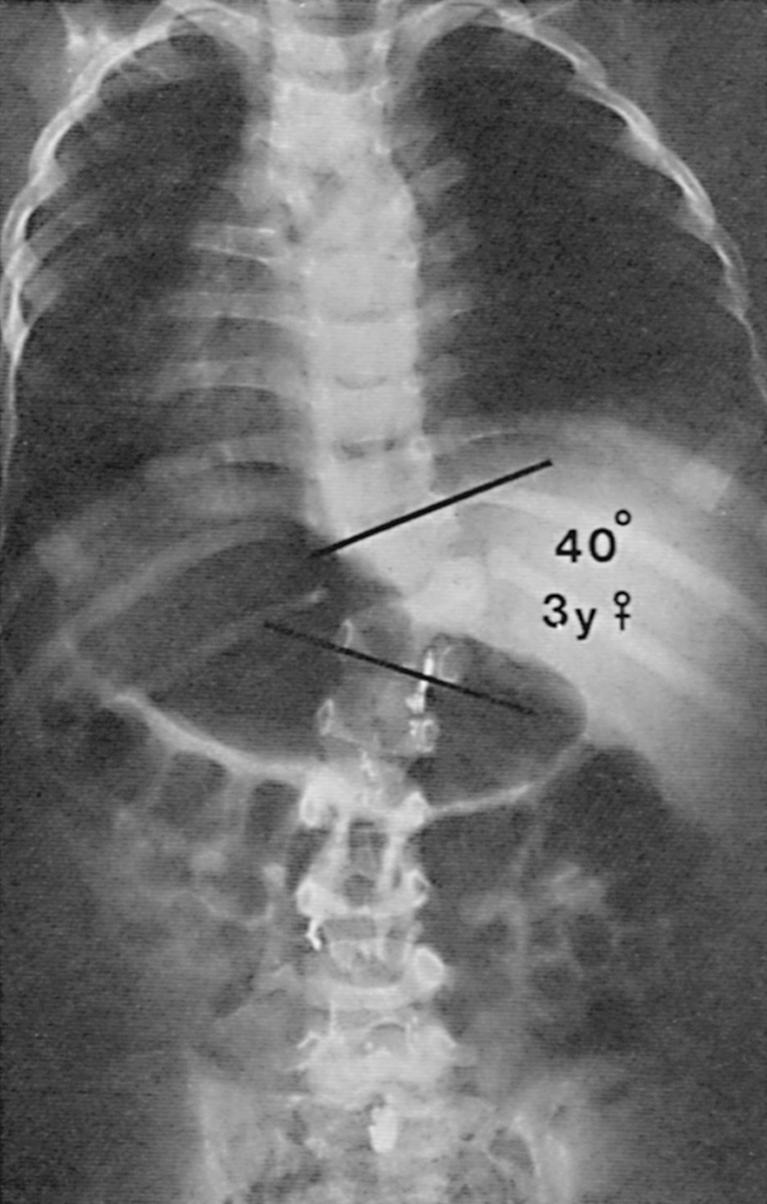
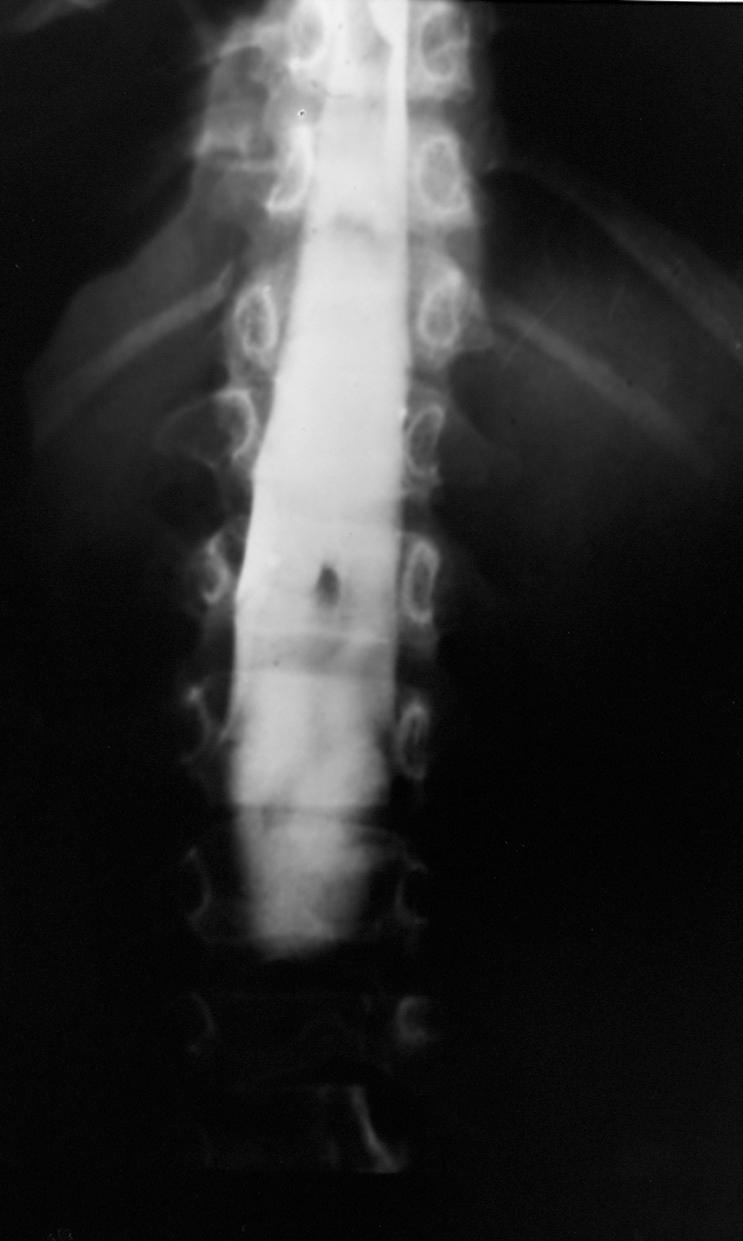
The risk for progression of congenital scoliosis depends on the growth potential of the malformed vertebrae. Defects such as block vertebrae have little growth potential, whereas unilateral unsegmented bars invariably produce progressive deformities. Approximately 75% of children with congenital scoliosis demonstrate some progression that typically continues until skeletal growth stops. Approximately 50% require treatment. Rapid progression can be expected during periods of rapid growth, such as those between birth and 2 years of age and those after 10 years of age. Orthotic management is usually contraindicated, because it poorly mitigates such a growth disorder. When progression is aggressive, surgery is necessary. This may consist of combined anterior and posterior hemi-epiphysiodesis on the convex side or possibly posteriorly approached osteotomies to halt progression and allow for some correction from growth on the concavity of the curvature.
Congenital kyphosis includes (1) failure of formation of all or part of the vertebral body with preservation of the posterior elements, and (2) failure of anterior segmentation of the spine (e.g., anterior unsegmented bar). The more severe deformities are usually recognized in the neonate, and they rapidly progress thereafter. The less obvious deformities may not appear until several years later. After progression begins, it does not cease until the end of growth. The most important factor regarding congenital kyphosis is the possibility that a progressive deformity in the thoracic spine can result in paraplegia. This potential outcome is usually associated with failure of formation of the vertebral body. When necessary, the treatment of congenital kyphosis is operative.
Sacral agenesis comprises a group of disorders with partial or complete absence of the sacrum. If the lower lumbar spine is also involved, it is called lumbosacral agenesis. Motor function is typically lacking below the level of the remaining spine; however, sensation tends to be present at a much more caudal level. The disorder can be classified by the amount of sacrum remaining and the articulation between the spine and pelvis. It is a rare disorder, occurring in approximately 1 in 25,000 live births, and the exact cause is unknown. The incidence is increased among the children of diabetic mothers (see Chapters 18 and 86 ).
The presentations of neonates with sacral agenesis can vary considerably. In severe forms, there is a small pelvis with pterygia anteriorly at the hips and posteriorly at the knees, as well as bilateral foot deformities, typically clubfoot. There may be spinopelvic instability. The neurologic examination tends to show no motor function below the last existing vertebra or sacral segment. However, sensation can be more variable. Children with sacral agenesis also have other visceral abnormalities similar to those seen in congenital scoliosis.
The treatment of sacral agenesis is variable. Those patients with only partial agenesis and a stable spinopelvic articulation can be observed. Those who are unstable may require a spinopelvic fusion in childhood for stabilization. This operation can enhance sitting balance and improve the function of the upper extremities. The problems associated with the lower extremities also require orthopedic intervention. If a child has the potential for ambulation, these problems need to be corrected to allow the child to assume an upright posture. Orthotics are usually necessary to support the extremities after they have been corrected.
The most common neonatal congenital and developmental abnormalities of the lower extremities include torsional and angular deformities; developmental dysplasia of the hip; proximal femoral focal deficiency (PFFD); congenital hyperextension, subluxation, and dislocation of the knee; clubfoot; metatarsus adductus; vertical talus; calcaneovalgus foot; and toe deformities, such as syndactyly and polydactyly.
The lower extremities of neonates commonly have mild to moderate bowing (i.e., genu varum) and internal rotation of the lower leg because of in utero positioning. The bowed appearance is actually a torsional combination of the external rotation of the hip (i.e., tight posterior hip capsule) and internal tibial torsion from in utero positioning. With the onset of standing and independent walking, the bowing and torsion are spontaneously corrected over a 6- to 12-month period. Significant improvement does not occur during the neonatal period or the first year of life. The typical neonate has 15 degrees of genu varum, which decreases to approximately 10 degrees by 1 year of age. By 2 years of age, most children have straight or neutrally aligned lower extremities. Treatment is indicated for children older than 2-3 years of age who have had no documented improvement with growth.
Become a Clinical Tree membership for Full access and enjoy Unlimited articles
If you are a member. Log in here